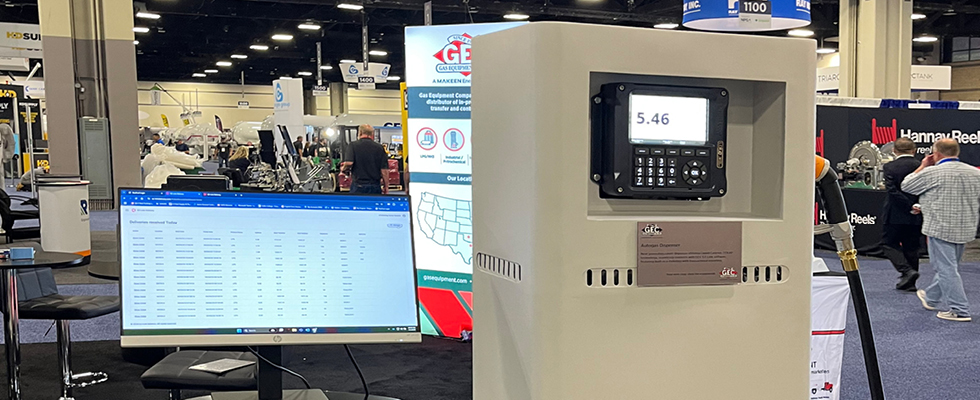
Gene Morrison began his career in the warehouse of Gas Equipment Company (GEC), a perfect placement that sparked his interest in the company’s OEM Fabrication Shop and the development of their next generation autogas dispensers.
“This aligned with my mechanical interests,” Morrison said. “I grew up tinkering with machines and electronics with my dad, so building [autogas] dispensers was very interesting to me.”

By July 2019, Morrison had progressed from an inside sales position — where he continued to learn more about autogas dispensers and code requirements for using the stations — to his current position of dispensing systems product manager. With the directive to take the department to what the future of GEC dispensers could be, he’s spent the past several years working directly with customers and end users to tailor GEC’s product line to what the industry was expressing a need for.
“I believe the customer input is vital to evolutions in equipment and our industry because that feedback allows you to adjust existing designs and innovate new products,” he said.
In his role, Morrison oversees the entire GEC product line and ensures the company’s standards of quality are met with every order that goes out the door. As a customer-facing representative for GEC, he attends multiple conventions each year, allowing him to foster and build relationships with manufacturing partners and end users. He’s also responsible for GEC’s technical support and installation/startup procedures, traveling to oversee the implementation of projects all over the country.
One of Morrison’s biggest projects is his involvement with the development of the NextGen Smart Dispenser, a notable entry into the autogas dispenser market. Morrison tells us more about the dispenser and his team’s design process in this Q&A below.
Can you tell us about the NextGen Smart Dispenser, i.e., its functionality, its use cases, etc.?
The NextGen dispenser uses the LCRiQ logic as our main component. The calculator is tried and true as a trusted piece of equipment in the industry. We have software coding that was developed by our integrated systems team that allows us to control the functionality of the register in addition to our transaction database. We have full operational capabilities of the equipment for tracking your fleet as an included component of the equipment. All that information is stored on our servers and delivered through our EZLink Office database. We are currently still running our beta testing phase with multiple locations operational; the reports coming in are all consistent for ease of use and installation, no maintenance, and a very sleek and modern design for high curb appeal.
When it came to the development of the Smart Dispenser, what was the catalyst for the idea?
GEC is a distributor first and foremost; this has always been who we are and will continue to be. But in our OEM Fabrication Shop, we have been taking more and more of a hands-on approach, building as many components as we can ourselves. This was the push for the development of this dispenser, to have an electronic registration autogas unit so that we control the production process as much as possible. This allows us to create a product that can be developed to the needs of the customers and be more aggressive with pricing — delivering a high-quality product at the most affordable price we can.
What was your role in the development of the dispenser?
I want to start by saying this was a complete team effort; without the support of my colleagues, this project would have been nothing more than a concept. I oversaw the entire design process for the dispenser to give us the sleek look we have. I also worked directly with the software team to create the database and functionality that I believe was needed based on the input from end users. I was part of every step of the design and layout for the equipment in our shop, using input from the entire team and customers to guide me to the final product.
Tell us about the design process — what considerations did your team consider to ensure a successful product that would meet a need in the market?
The primary focus of the equipment is durability; it will not matter how good it looks if it does not work. We wanted to ensure that the NextGen was simple and direct in design to allow for ease of service and use. The next consideration was to develop a product that does not ‘look’ like other dispensers in the market.
How does the dispenser ensure ease of use, clarity & efficiency for both first-time and frequent users?
The NextGen dispenser has a very simple design; the user interface is alphanumeric with an easy-to-read keypad. We interface the drivers and departments on the backend with software for simple keypad interaction. All of the control actions are automated, so the customer needs only to remove the nozzle from the holster once the transaction is authorized, and everything else will begin in sequence.
What sort of testing did the dispenser go through before hitting the market?
We are using existing hardware and software through the LCRiQ that allows us confidence in the equipment. Internally, we ran software and hardware testing for 10 months prior to the first units going into the field. We had also been running BETA units in the field for six months prior to introduction to the market.
What moments stand out as victories for your team during the design/development process?
The first thing that comes to mind was when we performed our first interface test of our software to the LCRiQ. This was the most important part of the project. If we could not make the controls work the way we needed, then the whole concept would have to go in a different direction. The other big win was when we first unveiled the unit at the National Propane Gas Association’s Southeastern & International Propane Expo. Hearing the feedback from all the customers that echoed what our hopes were from a design standpoint told me that we had nailed the needs and wants of the users.
How do equipment & technological innovations help to bolster autogas’ position as a viable fueling option in the United States?
Technology has come so far over the last 20 years that we are on par with other fuel sources. Now as we continue to demonstrate the economic and environmental benefits of propane as autogas, we need to have a product that looks and feels like what people are used to. Creating a unit that operates easily for minimal transition from the norm, while also having a more modern curb appeal, is the piece that is missing. My hope is that the NextGen dispenser can become a fueling station that [stands out in the market].
Why is it important for the propane industry to fully embrace autogas as a valuable avenue for growth?
Autogas gallons have huge untapped potential for marketers. These are gallons that will only add to their bottom line versus combating their growth in other sectors. Even a small fleet has the potential to add thousands of gallons annually to their volume and will see consistent returns on the investment. If we want to remain a viable industry for the next 100 years, then we have to find other sectors that can benefit from us. Autogas is the perfect opportunity, in my opinion.


